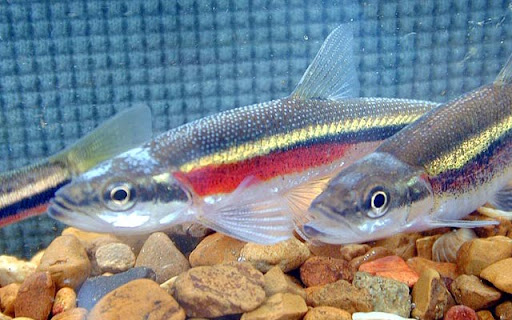ANIMAL: Southern Redbelly Dace Chrosomus erythrogaster Type of Animal: Cyprinid Habitat: Temperate clear flowing streams/rivers, clear spring-fed upland creeks, small clear cool creeks w/ gravelly/sandy bottoms & permanent water flow, clear cool spring branches w/ gravelly/sandy bottoms & permanent water flow, spring pools, small pools 1-3 ft deep w/ aquatic vegetation, bank overhangs among tree roots in clear pools w/ muck bottoms, narrow meandering streams w/ gravel/pebble/sand substrate, clear slow-flowing pools, steep banks, clear headwaters, clear spring-fed wooded streams w/ small pools/adequate overhanging vegetation for shade, undercut vegetated banks, riffles w/ clean gravel substrate, bank overhangs among tree roots in clear ponds w/ muck/gravel/rubble/sand bottoms, stream channels, off-channel wetlands, cool upland spring-fed streams w/ gravel/hard sand substrate & little to no silt, small to medium-sized clear spring-fed streams associated w/ watercress Location(s): C & E US from E Colorado/E New Mexico in W to W Pennsylvania/W New York in E as well as parts of Louisiana, Mississippi, Alabama, & Georgia in SE Appearance: Spindle-shaped small fish w/ horizontal black stripes & silvery area above, breeding males have red belly & red/yellow stripes, yellow fins Food/Diet: Algae, diatoms, detritus, plant matter, invertebrates, invertebrate larvae Status in Wild: Stable Conservation: Breeding in aquaculture, aquariums, & zoos. Monitoring of isolated populations in certain areas. Reintroductions into parts of range. Lifestyle: Schools of 20-200 fish Additional Info: Called: Male Female Young: Fry Group: School Weight: Male: 0.065 oz Female: 0.07 oz Gestation: 10 days Life Span: 2 years Body Length: Male: 1.185-2.393 in Female: 1.177-2.677 in Main predators are kingfishers, herons, bass, sunfish, trout, snakes, turtles, bullfrogs, salamanders, diving beetles, giant water bugs, otters, eagles, osprey, dragonfly larvae, water scorpions, backswimmers, mink, raccoons, & martens. These fish use their amazing vision to find food. Due to strong preference for clear waters, they’re important indicators of habitat health. Often school w/ other minnow species. During breeding, multiple males press against single female to stimulate egg release. They breed from April-June. They can spawn many times during breeding season. Active during the day (diurnal). Countershading on these fish helps them avoid predators. While stable overall, they face threats in certain areas from pollution, habitat alteration, & population fragmentation. Fun Fact(s): These fish sometimes used as bait fish. Name “dace” derived from old French word for dart due to darting behavior. Use chemical alarm signal to warn others of threats & for them to school together.
